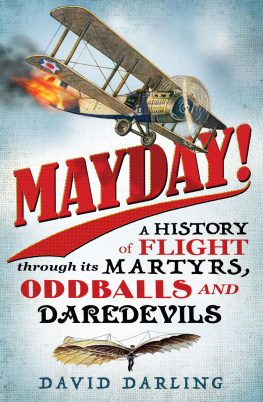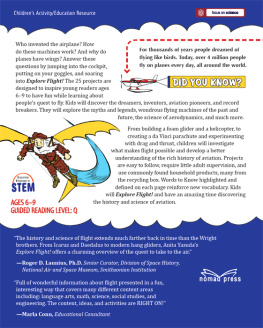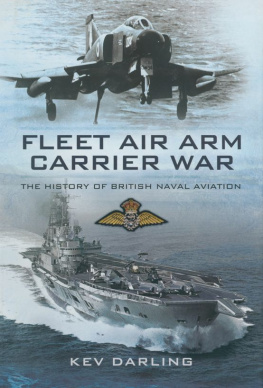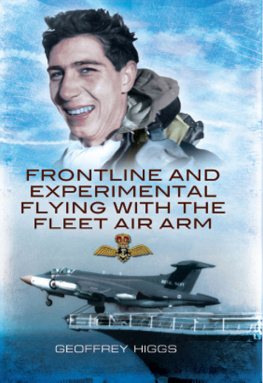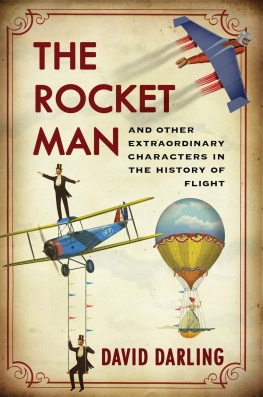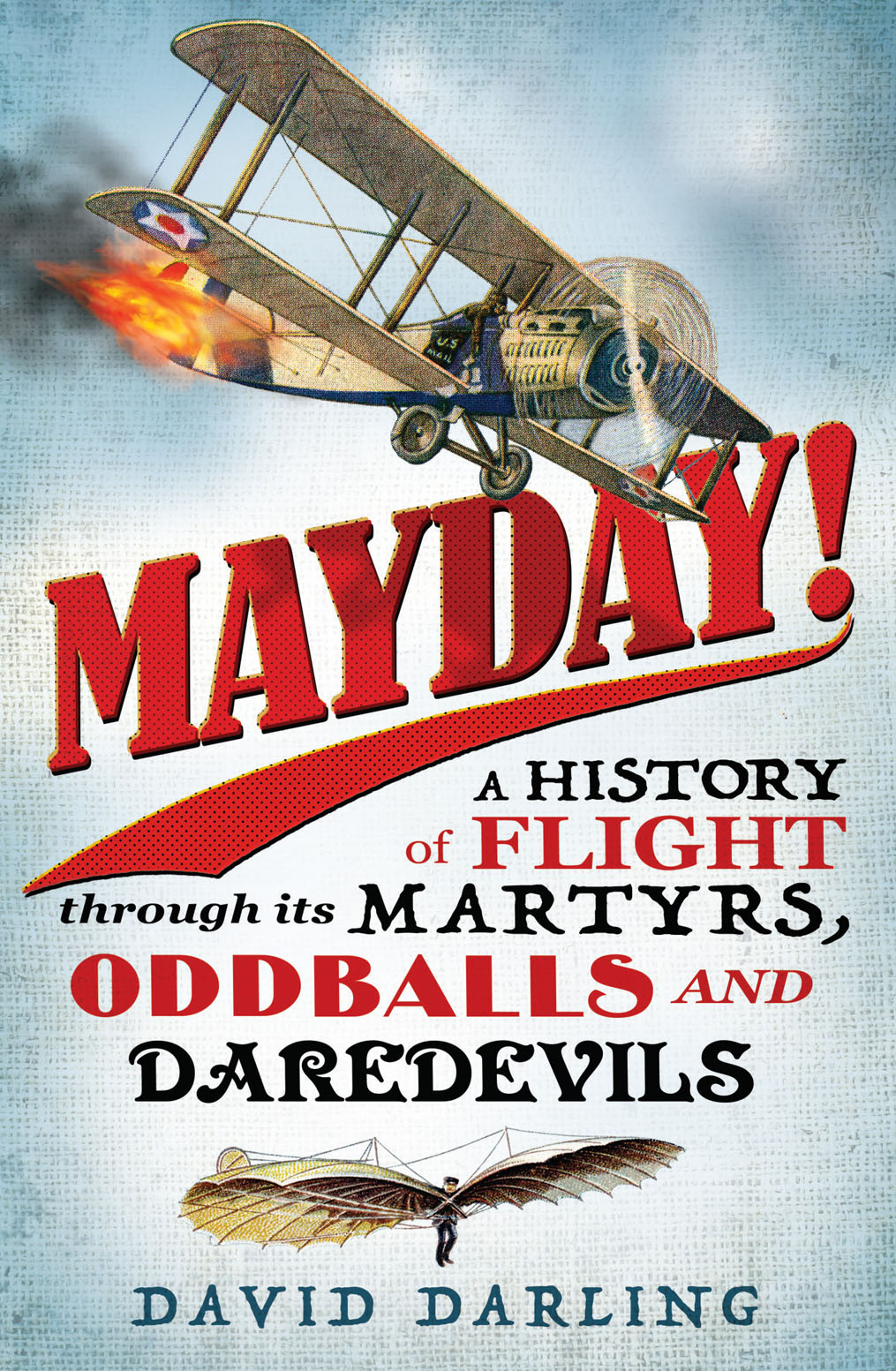List of Illustrations

Blanchards Balloon from Wonderful Balloon Ascents (1870) by Fulgence Marion (pseudonym of Camille Flammarion). Source: Wikipedia/public domain.
An early demonstration of the Montgolfier brothers balloon. Source: Wikipedia/public domain.
Sophie Blanchard standing in the decorated basket of her balloon during her flight in Milan, Italy, in 1811 to celebrate Napoleons 42nd birthday. Credit: US Library of Congress, Prints and Photographs division.
Lincoln Beachey seated at the controls of his plane (1913). Credit: US Library of Congress.
Lincoln Beacheys flight under Niagara Falls Bridge, 27 June 1911. Credit: Photo Speciality Co. (1911).
Lincoln Beachey in his plane racing against Barney Oldfield, 28 June 1912. Source: US Library of Congress.
Raymond Collishaw in RAF uniform (1919). Credit: RAF.
Royal Flying Corps or Royal Air Force Sopwith 1 Strutters. Credit: HM Government, Crown Copyright (expired).
Sopwith Triplane. Credit: Jeff Darling.
The Curtiss JN-4 (Jenny). Credit: Jeff Darling.
Ormer Locklear wing walking, c.1919. Credit: US Federal Government/public domain.
Wiley Post and Harold Gatty. Credit: German Federal Archive.
The Winnie Mae on display in the National Air and Space Museum. Credit: Jarek Tuszynski.
Howard Hughes standing in front of his new Boeing Army Pursuit Plane (Boeing 100A) in Inglewood, California in the 1940s. Source: US Library of Congress.
The first prototype of the Hughes XF-11, c.1946. Credit: US Air Force.
The H-4 Hercules, better known as the Spruce Goose. Credit: Jeff Darling & Federal Aviation Administration.
John Stapp rides the Gee Wizard at Muroc Army Airfield. Credit: US Air Force.
Upper: Stapp is prepared for his record-breaking run aboard Sonic Wind No. 1. Lower: Sonic Wind No. 1 hits the water trough that slowed it from 632 miles per hour to rest in little over a second. Credit: US Air Force.
Stapps face shows the effect of a high-speed trip aboard Sonic Wind No. 1. Credit: US Air Force.
The Bell Aircraft Corporation X-1 with shock-wave pattern visible in its exhaust plume. Credit: NASA.
Chuck Yeager standing alongside the Bell X-1, which he nicknamed Glamorous Glennis after his wife. Credit: US Air Force.
Neil Armstrong next to the X-15. Credit: NASA.
Joe Walker exiting his X-1A, cowboy style. Credit: NASA.
Joe Walker after a flight of the X-15 #2. Credit: NASA.
Joseph Kittingers record-breaking skydive from 102,800 feet (31,300 metres). Credit: US Air Force.
Joe Kittinger and the recovery crew following his record-breaking jump.
The Johnsville centrifuge. Courtesy: Johnsville Centrifuge & Science Museum.
The Mercury Seven astronauts with a model of an Atlas rocket. Standing, left to right, are Alan B. Shepard Jr, Walter M. Schirra Jr, and John H. Glenn Jr; sitting, left to right, are Virgil I. Grissom, M. Scott Carpenter, Donald (Deke) Slayton, and L. Gordon Cooper Jr. Credit: NASA.
Alan Shepard poised on the step of the Johnsville centrifuge prior to a training run. Courtesy: Johnsville Centrifuge & Science Museum.
The Iron Maiden, a device patented by R. Flannigan Gray. Credit: Johnsville Centrifuge & Science Museum.
The MASTIF (Multiple Axis Space Test Inertia Facility) at Lewis Research Center in 1960. Credit: NASA.
An SR-71 Blackbird flies over the snow-covered southern Sierra Nevada Mountains of California after being refuelled by a US Air Force tanker during a 1994 flight. Credit: Jeff Darling & USAF/Judson Brohmer.
NASAs SR-71 taking off from Dryden Flight Research Center. Credit: NASA.
Voyager circling before landing at Edwards Air Force Base. Credit: NASA/Thomas Harrop.
Voyager specifications. Credit: Jeff Darling.
Yves Rossy, aka Jetman or Rocketman, flying with his jet-propelled wing. Credit: Yves Rossy/Breitling.
Aiguille du Midi (Needle of the South) in the French Alps over which Patrick de Gayardon flew in 1997. Credit: Wikipedia/Garrondo.
Yves Rossy. Credit: Yves Rossy/Breitling.
Rossy flying over the Grand Canyon. Credit: Yves Rossy/Breitling.
Rossy flying in formation with two jets from the Breitling demonstration team. Credit: Yves Rossy/Breitling.
BASE jumping from an antenna. Credit: Wikipedia.
Steph Davis performing a BASE jump in a wingsuit. Credit: Wikipedia.
A wingsuit flier in Holland. Credit: Vladimir Lysyuk/Jarno (Mc) Cordia.
Introduction

Do you want to jump into thin air with nothing but a pair of outsized bird wings stuck to your back, or take off clinging to a rickety framework of wood and canvas? Do you want to fly higher, faster, or further than anyones done before in some contraption that looks like its held together by school glue and wishful thinking? Then youre ready to join the club of pioneering aviators: that band of daredevil adventurers who have risked life and limb to push back the boundaries of flight.
But dont expect to live long. The survival rates for those who went up in the early balloons and planes arent encouraging. Many of the characters in this book ended up in fatal or near-fatal crashes taking one risk too many. Hydrogen balloons caught on fire and plummeted to the earth, early winged craft flipped or broke apart or just plain fell out of the sky, pushed beyond their limits. The German Otto Lilienthal the Glider King lasted longer than most. He built and tested a variety of his own craft at the end of the nineteenth century and even made an artificial hill near Berlin as a launch pad. Between 1891 and 1896, he and his brother Gustav flew about 2,000 times, risking death every time they leapt off the slope. Eventually, Ottos luck ran out: his glider stalled, and he fell more than fifty feet, snapping his spine. He died the next day uttering the final words: Kleine Opfer mssen gebracht werden (Small sacrifices must be made).
The fatality rate among early exhibition aviators was terrifyingly high around ninety per cent. They not only vied to out-do each other, they were flying planes at a time when designers were still battling to understand the most basic problems in aeronautics. Arch Hoxsey and Ralph Johnstone starred in the Wright brothers exhibition team formed in the spring of 1910. For a brief time they enthralled crowds around the States and were dubbed the Heavenly Twins by newspapers, but by the end of the year both had been killed: Johnstone when his aircrafts wings broke off during a spiral glide and Hoxley while trying to set a new altitude record. Working for the rival team of Glenn Curtiss, Charles Daredevil Hamilton flew dirigibles and made death-defying parachute jumps. No stunt was too outrageous for him and, incredibly, he survived more than sixty crashes, though he was permanently scarred, had two replacement silver ribs, and needed metal plates in his skull and shin.

